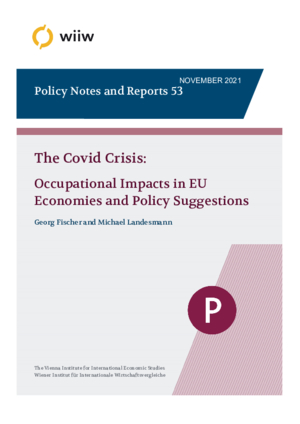The Covid Crisis: Occupational Impacts in EU Economies and Policy Suggestions
Georg Fischer and Michael Landesmann
wiiw Policy Note/Policy Report No. 53, November 2021
36 pages including 12 Tables and 5 Figures
This policy note examines sectoral and occupational employment impacts of the Covid-19 crisis. The crisis hit EU economies (and advanced economies in general) as they were already undergoing important structural changes due to technological change (digitisation), a factor affecting most organisations now and in the future. Some of these changes accelerated during the pandemic, along with at times dramatic changes in sectoral demand patterns (due to lock-downs) and shifts in work organisation, all of which had strongly differential impacts on various occupational groups. The policy note studies in-depth occupational employment patterns before and during the pandemic using detailed Labour Force Statistics, including analysis of the differentiated impacts on women and men. The major policy challenge is to avoid lasting gaps in overall employment as economies recover and as temporary support schemes are phased out. Further, policy makers need to focus attention on how to accompany the continuing changes in structural employment patterns. These changes can have significant and lasting impacts on the employment prospects of different segments of the labour force (in terms of age, gender and educational/skill levels). The policy note postulates a number of policy actions which should be embarked upon, both at the national and EU level.
Keywords: Covid-19 crisis, employment impact, occupational and sectoral impacts, gender impacts
JEL classification: J01, J08, J23, J24, O52, O57
Countries covered: European Union, New EU Member States
Research Areas: Labour, Migration and Income Distribution
